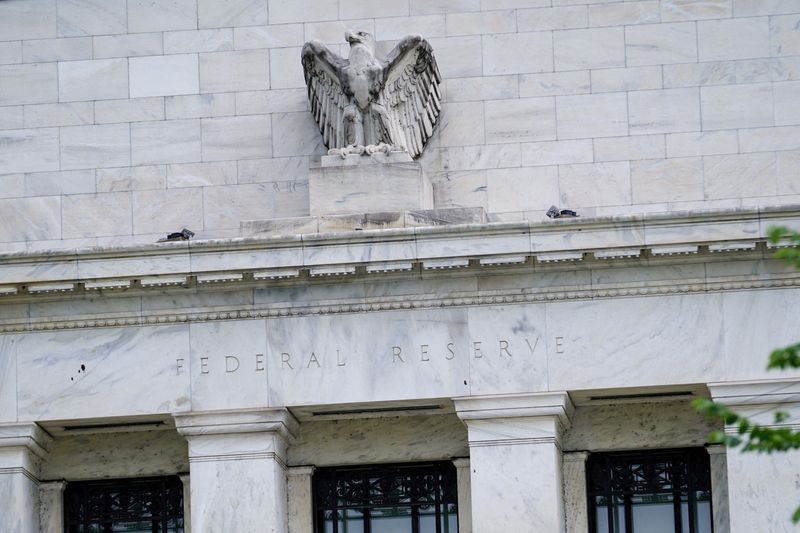LONDON (Reuters) -Central banks in Australia, Britain and Sweden will meet this week, as markets assess how much leeway the U.S. Federal Reserve has to cut rates this year.
Traders are on alert for Japanese currency intervention, while weighing up the effects of U.S. market turbulence. And the around-the-world election tour makes a pit-stop in Panama.
Here's what is in store for global markets in the week ahead from Rae Wee in Singapore, Ira Iosebashvili in New York, Andy Bruce in Manchester, and Naomi Rovnick and Marc Jones in London.
1/ DISTURBING GOLDILOCKS
U.S. consumers are in focus as the University of Michigan's preliminary reading on consumer sentiment in May gives a snapshot of their inflation expectations and economic outlook.
Months of stubborn inflation have threatened to disrupt the so-called Goldilocks narrative of resilient growth and cooling consumer prices that have helped drive stocks higher.
Any signs in the May 10 report that higher prices are weighing on sentiment could encourage the Fed to keep rates elevated, adding to recent pressure on stocks and bonds.
The Fed on Wednesday acknowledged a recent lack of progress on inflation, although Chair Jerome Powell reiterated that rates are likely to fall in 2024 and Friday's soft jobs numbers supported that view. Economists polled by Reuters expect the consumer sentiment index to rise to 77.9 from 77.2 in April.
2/ RUN FOR SHELTER
Investors are scouring the globe for shelter from turbulence in U.S. markets shaken by the Fed's reluctance to cut rates. The S&P 500 dropped more than 4% in April, while Treasuries had their worst month since September.
Investors are trying to diversify.
London's FTSE 100, considered a hedge against tech-dominated S&P weakness because of its large crop of companies in so-called value sectors like oil and mining, is near record highs. Stocks in high-growth India have logged three months of gains.
But insulating a portfolio from Wall Street's swings is tough. The long-term correlation rate between Europe's Stoxx 600 and the S&P is almost 90%, investment bank Baird estimates. Barclays calculates that a one percentage point rise for Treasury yields commonly pulls global yields up 56 bps.
3/ WAITING GAME
Flashes of illumination rather than fireworks are likely to emerge from the Bank of England on Thursday, when it publishes its May rate decision and new quarterly forecasts.
While earlier this year rate-setters talked openly about the possibility of rate cuts, hard data and business surveys have painted a pretty mixed picture of price pressures in Britain's economy, much like in the United States.
With scant fresh data scheduled between now and Thursday, investors are increasingly betting the BoE could even wait until September before cutting rates.
The results of local elections - which look set to pile yet more pressure on Prime Minister Rishi Sunak - are due from Friday, with monthly economic growth data due on May 10.
Elsewhere in Europe, Sweden is seen as likely to start cutting rates on May 8 as inflation falls faster than expected.
4/ UP, NOT DOWN
The Reserve Bank of Australia meets on May 7 and it's poignant timing after Q1 inflation were hotter than expected, after the RBA in March watered down a tightening bias.
No policy change is expected but markets will watch any comments from Governor Michelle Bullock closely.
Having been spooked by the inflation figures, markets narrowed the odds on the RBA having to raise rates once more. Note, some of those bets were pared after Australian retail sales fell unexpectedly in March.
Even so, the risk of another rate hike has done little to help the Aussie, which continues to struggle below the $0.66 level against the dollar.
5/ WHAT NEXT, MULINO?
Panama's former security minister Jose Raul Mulino on Sunday stormed to victory in a presidential poll dominated by his old boss, the popular ex-leader Ricardo Martinelli, who buttressed his campaign despite being holed up in Nicaragua's embassy.
Now comes the challenge of governing.
The Central American country is at serious risk of losing its coveted 'investment grade' status, having already been chopped to 'junk' by Fitch.
Its business-friendly reputation has been tarnished by a decision to close the huge Cobre Panama copper mine that provides some 5% of its GDP. All this while the drought-hit Panama Canal's contribution to state coffers is expected to fall nearly 3% this year.

Mulino will need to improve the finances to win over ratings firms.
He said his government would be pro-investment and pro-business and that Panama would honor its debt, but also vowed not to forget the poor.
(Graphics by Pasit Kongkunakornkul, Kripa Jayaram, Prinz Magtulis and Marc Jones; Compiled by Dhara Ranasinghe; Editing by Alexander Smith and Bernadette Baum)